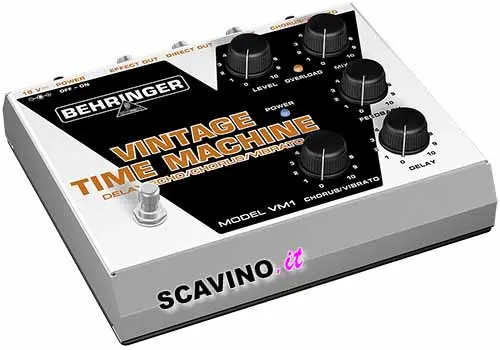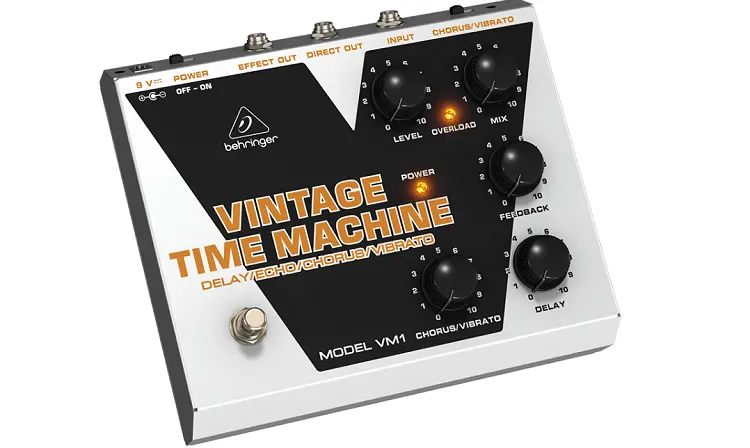
Guitar effects, especially the modulation branch of the family, are almost irreplaceable in today’s day and age.
Every guitar player who isn’t a complete purist, has some kind of pedalboard setup, or at least a selection of pedals they use on a daily basis.
Most people opt to go for individual pedals since they are known to offer the best possible performance. The opposite of this are the effects processors which offer a whole variety of different effects. However, the quality of sound between these two is vastly different with processors being inferior ones. With that said, there are some middle of the road solutions out there.
Behringer Vintage Time Machine is an effects pedal that combines several effects into one unit. It’s not really a processor, nor does it have nearly as many options as one. This Behringer pedal offers a limited variety of effects, but delivers them in a way that makes them sound organic and somewhat natural.
[su_highlight background=”#fcfa8a”]BEHRINGER VINTAGE TIME MACHINE VM1 on Amazon[/su_highlight]
The only question is how successful was Behringer in this endeavor? Is their creation good enough for everyday stage use, or is it just something that belongs in band practice at best?
Let’s find out.
Just by seeing the cover picture for this article, you probably figured out by now that this pedals is anything but compact. That leads us to the question of how important is the size of an effects pedal. In general, there are several reasons why effects pedal manufacturers avoid making chunky stompboxes. Commercial pedalboards, and homemade ones as well, are pretty much standardized.
This means that the person who designed the board calculated its size based on dimensions of your average pedalboard. Imagine Boss DS1 or something similar. That is usually what designers look to when they are deciding how large a board should be.
So when you introduce a pedal that is of unusual size and dimensions, it can be a problem. That is strike one for Behringer Vintage Time Machine.
Features
For what it is worth, this pedal is pretty sturdy. The large form factor is a minus, but it brings some weight, which in turn inspires confidence. There are several knobs and switches on the top panel that you use to control the effects. Speaking of which, the graphic design they chose for this model give the pedal a very vintage type of vibe. That is something many will and do find attractive.
On the very top you will find the level and mix knobs. Former is pretty self explanatory, while the latter enables you to choose the amount of impact the pedal will have on the signal chain. Underneath the mix knob is the feedback control, followed by delay and chorus/vibrato knob. To the far left your activation switch.

One of really important features is the true bypass this pedal comes with. Being able to completely exclude the effects of this stompbox on your signal chain is pretty important, especially considering the nature of Behringer Vintage Time Machine. Given that this is something you should expect to see in this price range, not every pedal comes with true bypass even in this category.
Performance
What Behringer tried to accomplish with this pedal is authentic emulation of ’70s modulation effect. Even the design of the pedal hints of this. What you can expect to hear is something similar to the Memory Man and other effects in that range.
Vibrato is pretty precise, and the chorus has an organic feel to it. Is it going to properly emulate its analog counterparts? Definitely not, but Behringer Vintage Time Machine offers a taste of these legendary effects in a very practical way. However, even though the effects sound pretty decent, there are some issues that need to be mentioned.
 For one, the switch is noisy. When you go to turn the pedal on or off, chances are you will hear a click of some sort, or other noise. This takes away from the practical value of this pedal. However, it appears to be a random occurrence. Some pedals have this issue while others don’t.
For one, the switch is noisy. When you go to turn the pedal on or off, chances are you will hear a click of some sort, or other noise. This takes away from the practical value of this pedal. However, it appears to be a random occurrence. Some pedals have this issue while others don’t.
What we like
Emulating vintage effects is often times very difficult since most of them have been achieved using analog systems. When exactly will digital setup be able to completely replicate the sound of an analog one is yet to be seen, but it sure isn’t today. With that said, Behringer Vintage Time Machine comes pretty close. Close enough that it’s worth the price you are asked to pay at least.
What we don’t like
No matter how good the quality of effects is, there are some things about this pedal that are just not that great. First and foremost it’s bulky. If you have a tightly organized pedalboard, this thing will cause havoc.
Next big thing is quality control that seems to be spotty at best. Some units work perfectly while others come with issues that you should have to deal with. That’s a pretty big shame considering Behringer Vintage Time Machine has a lot to offer in terms of performance.
Everything considered
Whether or not you will find Behringer Vintage Time Machine to sound good is up to your taste, and how high your standards are. It’s definitely better than your average modulation box that has more than one effect available. Its chunky size may be an issue for a lot of guitar players, but squeezing this thing on a pedalboard is definitely worth the effort.
The only real issue that we find alarming is the quality of the switch. Behringer dropped the ball a bit in this area, but then again they don’t really have a spotless record to begin with.
At the end of the day, you need to put pros and cons on a piece of paper and figure out whether or not you are willing to make the necessary compromises. If performance is the only metric, this pedal is definitely worth getting. Still, it’s up to you.




